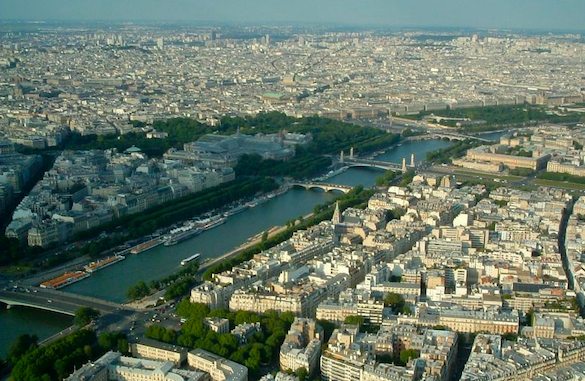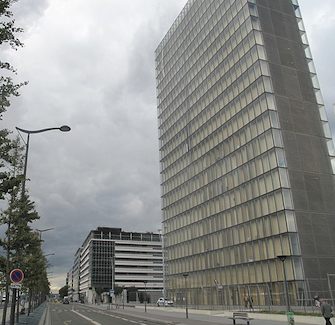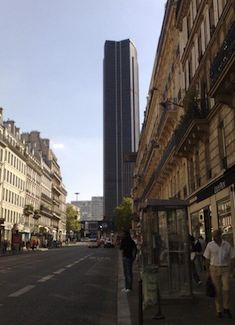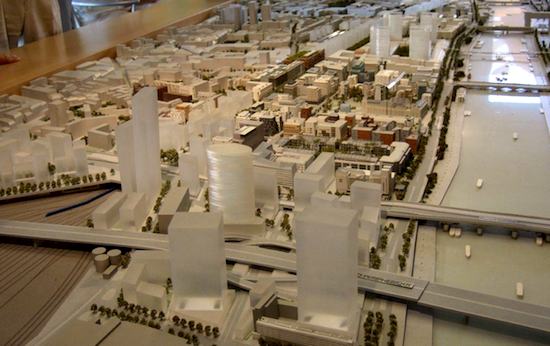News: More Unwanted Paris High Rise Towers Ahead?

- SUBSCRIBE
- ALREADY SUBSCRIBED?
BECOME A BONJOUR PARIS MEMBER
Gain full access to our collection of over 5,000 articles and bring the City of Light into your life. Just 60 USD per year.
Find out why you should become a member here.
Sign in
Fill in your credentials below.

One recent Friday, I stood in the autumn sunshine outside the Métro station near the Gare d’Austerlitz in Paris. Just across the street was the 5th arrondissement, home to the Panthéon and other great monuments known to the whole world. But I was in a district tourists rarely visit, the formerly industrial Paris 13th. About a half dozen members of the architectural preservationist organization SOS Paris and I met with experts from the Council for European Urbanism (CEU), an international group. SOS Paris fights to protect the architectural monuments of Paris and is campaigning to save the low skyline. Our two groups were going to visit sites where the City of Paris plans to build towers, plans that SOS Paris opposes.
Members of the CEU board were in Paris to conduct research for a white paper about those towers. They are experts, and their report can be influential, but they said they had no preconceptions. That day we visited the showroom of Semapa, a public-private developer already refurbishing factories and warehouses, and planning towers, in “Paris Rive Gauche,” a development area in the Paris 13th.
Towers in Paris? Paris has had height limits for hundreds of years, and polls show a majority of residents oppose towers. La Tour Montparnasse, completed in 1973 during a period of relaxed limits, is 50 stories (210 meters) tall. Because Paris is so low, and the Tour Montparnasse is so tall that it blots the skyline, it is universally hated, so in 1977 lower height limits were again imposed: roughly 10 stories (31 meters) for lodgings in the center, and 12 stories (37 meters) on the periphery of Paris. Arguing that Paris needs towers to house more young families, however, in July 2008 the Paris City Council raised the limit for housing on the periphery to about 16 stories (50 meters), and it authorized six skyscraper projects at the gates of Paris, up to 50 stories tall.
We stopped first at the Gare d’Austerlitz, one of the six nineteenth-century railroad stations of Paris, and now a tribute to the effectiveness of SOS Paris and other associations. Our young guide was Yann Renaud, who works in the Associations Consultation Office, which Semapa established, as required by law. The station will become a transportation hub for high-speed and suburban trains and the Métro. In the original 1991 plan, Yann said, the main station survived, but not the historic auxiliary buildings. Now, however, owing to the efforts of SOS Paris and others, only one small building will be destroyed.


Photos left to right: Bibliothèque Nationale de France and Tour Montparnasse. Photos: Wikimedia
We walked eastward along the almost silent sidewalks of the Avenue de France, lined with new suburban-style office buildings. At the showroom of Semapa, a model showing all of Paris stretched across a room-sized table. At one end, we could see the streets of old, low, central Paris, with the Panthéon, the spire of Notre Dame, and the Eiffel Tower. Traditional Paris is tightly packed with boxy blocks of six- and eight-story apartment buildings with central courtyards built up against each other, and cut by wide avenues with vistas of great monuments. This is how Baron Georges Haussmann and the Emperor Napoléon III rebuilt the medieval city in the nineteenth century. The extraordinary density of Paris, greater than that of Mumbai, supports the Métro system and produces bustling street life, with cafés and shops.
Circling the tiny city was the multi-lane beltway called the Périphérique, completed in 1973. The Périphérique is one of the few accommodations to the automobile that historically transit-oriented and pedestrian-friendly Paris has made. From the Middle Ages into the twentieth century a succession of walls ringed Paris. First the city would expand beyond a wall, and then the wall would be torn down, the city limits moved out, and a new wall constructed. This sequence stops at the highway.
Directly before us was the 13th arrondissement. Next to the Seine was the most conspicuous new building in the 13th, the Bibliothèque Nationale de France, dating from 1996. Along with the Opéra Bastille, the Centre Pompidou, and I.M. Pei’s pyramid in the Louvre, it is one of the grands projets of President François Mitterrand. An enormous low box, it presents intimidating stairways to visitors, not shops or cafés. Its four right-angled glass-walled towers for stacks cleverly resemble open books, but sunlight ruins books, so wooden louvers had to be added.

Photo of the Semapa model by ©Jan Wyers
On the model, the tall plastic skyscrapers we had come to see nestled close to the Périphérique. Yann said that the skyscrapers would be up to 43 stories (180 meters) high. Two will be office buildings, and the top floors of a third probably a hotel. The lower apartment buildings in the project will be up to 15 stories (50 meters) high, taller than traditional Parisian buildings, and not tightly built along the street with interior courtyards, as in traditional Paris. The skyscrapers do promise marvelous views. But someone asked, “How can office buildings or a hotel house more young families?”
The next afternoon, our guide to a second site, at the Batignolles in the 17th arrondissement, was Corinne LaBalme, an enthusiastic longtime resident. Corinne, a writer specializing in architecture and food, and editor of La Belle France, said that the 17th is rapidly commercializing. Banks are replacing small shops, and apartment prices have nearly tripled in five years.
In the 19th century, Corinne said, as we walked along the bustling streets, the Batignolles was a working-class neighborhood and an artists colony, “for poor artists.” Residents included Henri Fantin-LaTour, Edouard Manet, Auguste Renoir, and Émile Zola. We crossed the Square of the Batignolles, a charming park on the English model containing plants from all over the world, with winding pathways and a pond with geese and frogs.
The small building where the City presents plans for the Batignolles project is at the edge of the unused rail yards. We gazed at a photomontage showing that vast space and the towers to be erected. Such a lost opportunity to use the lessons of successful Paris urbanism! The city will build office buildings and lodgings, including subsidized housing. Taller than Haussmannian buildings, at a maximum 12 stories, they will not be joined to one another. Nor will they be lined up along the street in traditional Paris style, but instead, isolated in a new park. The highest tower, for the courts, is a project of the central French government, and press releases say it may be 40 stories tall. Both the courthouse tower and a lower building for the police will be built at the far end of the space, against the Périphérique.
The president of SOS Paris, Olivier de Monicault, pointed out that all of the tower projects announced so far are sited in between the boulevards and the Périphérique, including also the so-called Projet Triangle in the Paris 15th. They are not pedestrian-oriented and transit-oriented, as traditional Paris is, but in fact highway-oriented. That might be appropriate in the suburbs, but SOS Paris contends the towers will destroy the low-rise, urbane skyline of Paris.
The CEU white paper, expected within two to three months, will analyze the economic effects of the proposed towers, their sustainability, and their effects on local character. We look forward to it with keen anticipation.


